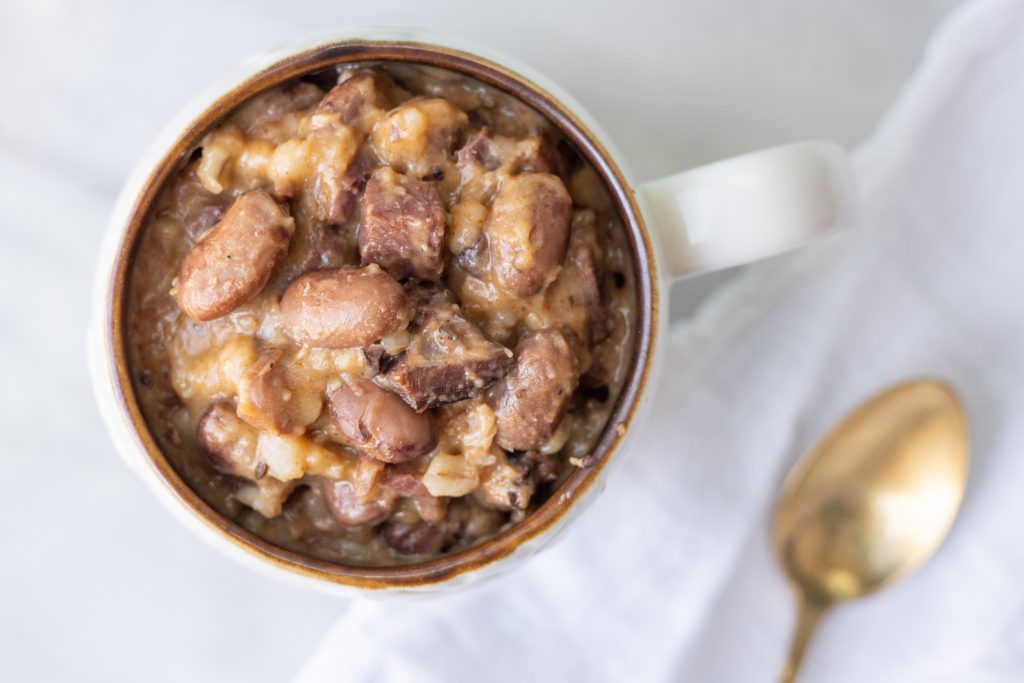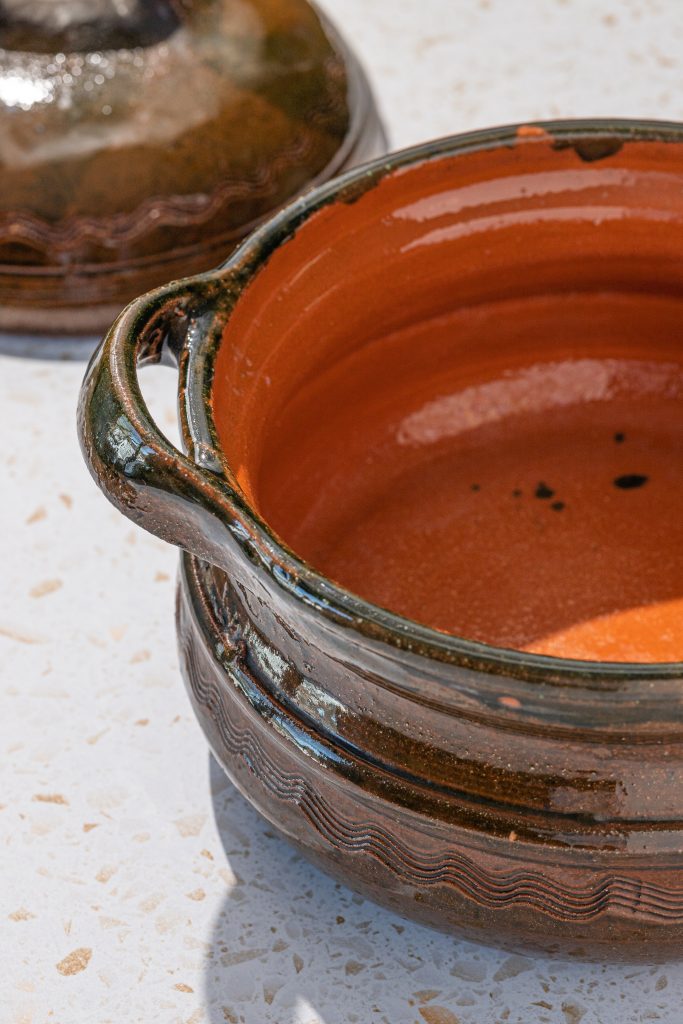Bakehouse managing partner Amy Emberling originally wrote this post about sólet-tasting in Budapest in 2012, for the Zingerman’s Community blog. Luckily for you, there’s no need to travel to try it—we’re making sólet every Sunday in February.
We’re resharing her story in honor of Hungarian Month at the Bakehouse! (Read more about why we’re hooked on Hungarian baked goods.)
At the bakery we’re studying Hungarian foodways, which include a rich collection of Jewish recipes. Jewish communities have existed in Hungary since at least the 1100s when we know for certain of their existence because of references to Jews in written court records. Jews were treated relatively better in Hungary than in many other European countries (had even been granted full rights of citizenry) until World War II when they were the last Eastern European Jews to be targeted by the Nazi extermination policy. Since the campaign came nearer the end of the war a greater number of people survived and returned to Hungary where they appeared to live as non-Jews during communist rule.
In the twenty-some years since the fall of the Berlin wall, the Jewish community in Hungary has become more visible and vibrant. Budapest currently has the largest and most active Jewish community in Eastern Europe. The result for Hungarian Foodways, of 900 years of Jewish/Magyar co-existence is a surprising appearance of Jewish foods as standards in the Hungarian repertoire – latkes, matzo ball soup, and cholent to name three – even called by their Yiddish names! Discovering all of this has certainly been eye opening.
Today’s Magyar story is about our acquaintance with the traditional Hungarian and Jewish bean dish called sólet in Hungarian and cholent in Yiddish. Sólet is a traditional slow cooked stew. It is usually simmered overnight for 12 hours or more, and eaten for lunch on the Sabbath to conform with Jewish laws that prohibit cooking on the Sabbath. The pot is brought to boil on Friday before the Sabbath begins, and placed in a slow oven until the following day. There are many variations of the dish and the basic ingredients of cholent are meat, beans, and barley. It’s not dissimilar in style of cooking from the famous French dish cassoulet or American baked beans.

Learning about sólet
Prior to coming to Hungary my knowledge of sólet/cholent was sketchy. Years ago, I asked my grandmother (one of my sources for traditional Jewish food knowledge) about cholent and she didn’t have much to say. Rather, it got her reminiscing about other traditional dishes that she hadn’t eaten in a long time, which was interesting for other reasons, but the cholent question wasn’t answered. My mother, another source for traditional Jewish food information, said she’s never eaten it and responded in a way that made me think I wouldn’t want to.
Hmm…whom to ask now? Well, my friend Michael Fahy, who I often turn to for general history questions if my archaeologist husband doesn’t know, seemed like he might be a good bet. Besides having what seems like a vast and eclectic internal database of facts, he’s by far the most Jewish person of Irish descent I’ve ever met. He had the most to say about cholent, and amazingly his connection to it was also Hungarian, via Israel, about 30 years ago. Michael was living on a Kibbutz in Israel in the 1970s, which had many Hungarian Jewish residents, some of them Holocaust survivors. According to Michael they really looked forward to their Sabbath cholent every Saturday. It was an important part of their Sabbath tradition. He remembered it as a relatively plain and heavy bean dish.
Sólet tasting in Budapest
This spring a number of us from the bakery visited Budapest to continue our studies of Hungarian foodways. Sólet was on our itinerary. Finally I could have first hand experience of this classic dish. No one else on the trip had any prior knowledge of sólet or any personal connection to it but somehow it became the hit of the trip. Who would’ve thought? We ate it in three different venues; only one considered a Jewish restaurant and thoroughly enjoyed deciphering their differences. The sólet at Kadar’s was considered the best but more about that later. Not only did sólet grab the group’s tastebud attention, but it was the first Hungarian food made by any of us on our return. (Shelby, our BAKE! principal made it a few days after our return.)
 Additionally, the most prized souvenir from the trip is a well used ceramic cholent pot which I hand carried back with the reverence and care usually reserved for a long lost family bible or art treasure. Since we are now all sólet enthusiasts, we decided that the cherished pot would reside at the bakery to be shared by all of us when the mood for cholent cooking hit.
Additionally, the most prized souvenir from the trip is a well used ceramic cholent pot which I hand carried back with the reverence and care usually reserved for a long lost family bible or art treasure. Since we are now all sólet enthusiasts, we decided that the cherished pot would reside at the bakery to be shared by all of us when the mood for cholent cooking hit.
The sólet we ate in Hungary was varied and delicious. The dishes were generally a mix of small red beans and barley cooked with onions, paprika, a little garlic, some kind of meat, and a liquid. It was created to be a dish that would cook properly in a wood-burning oven that was no longer being used so the temperature was decreasing. Jews could put the dish in the oven before sundown on Friday and leave it until Saturday when it would then be ready to eat—meaning no work was done on the Sabbath itself. On our trip we learned that it had been a convenient dish for Hungarians in the past when they were living with wood-burning ovens, so who knows which direction this dish went in the mixing of the foodways.
Sólet at Kadar’s
My first encounter of sólet was at Kadar’s a restaurant in Budapest which had opened in the 1950s, is now on its second owner and was famous for its sólet, although it serves many other things and in no way was known as a Jewish restaurant. Kadar is a Hungarian surname. Gabor, our guide and friend called to reserve several servings for us because it was Saturday and they were known to sell out (“Bubbe, 86 the sólet!” I like the way that sounds.) I couldn’t wait. Finally I was going to taste this almost mythical dish and we’d be in a restaurant famous for it and they served many versions!
Before I tell you about the sólet, let me describe the restaurant. It’s tiny. It’s crammed and it’s plain. The owner, tall, broad, and imposing, is taking orders and bringing out the food. It’s a down-to-business experience. Our server was a middle-aged woman who’d been there longer than the owner, close to 30 years and claimed to be better at making the sólet. The clientele was mixed with natives and a few tourists. Each table had seltzer water on it and the walls were lined with signed pictures of famous people who had enjoyed a meal there.
We ordered matzoh ball soup, on our quest to taste it in as many places as served it, and the sólet started arriving. Three separate plates came each with beans and one with a baked egg, one with roast goose and one with a pork chop! Yes, sólet with pork. There were many versions of different pork cuts with sólet on the menu, a true intermixing of cuisines. The beans and barley were moist and moderately seasoned—quite satisfying! The group seemed excited about this first encounter. Nina Huey (nee Plasencia) loved the dish, claiming that it spoke to her Hispanic beans and pork heritage.
Sólet at Fülemüle
Our next sólet encounter came at Fülemüle, a restaurant known for serving Jewish dishes as well as Hungarian standards, which opened in the early 1990s. It is owned by András Singer, a Jewish restaurateur committed to serving delicious and refined food. His most prized dish is his smoked meat, which he claims is better than Schwartz’s in Montreal. He travelled to eat at Schwartz’s several times while he was developing his own. If you haven’t been to Schwartz’s, it’s definitely worth a trip.
Nina, so taken with her first taste of sólet, ordered the Kind David sólet, which came with roast goose, smoked meat, and hard-boiled egg. It was big enough for at least three people, was quite delicious, especially the smoked meat and equally moderately spiced as the cholent at Kadar’s. The beans and barely were a bit less moist however. We were getting a hint that moisture was going to be one of the keys to the sólet’s success. You might be wondering about all of the goose being served. It’s very prevalent in Hungarian cuisine, including foie gras and Jews were historically the goose farmers of the country.
Sólet at Thummerer Winery
Our final encounter with sólet was at the family-owned Thummerer Winery, northeast of Budapest. Sólet in a winery? You bet. We came to Thummerer to cook, bake, and taste wine for the day with the chef András and his wife Éva, the daughter of the winery founder. The dynamic and talented pair play a very important role in running the winery now. We were using a wood-burning oven to roast a goose, and then the next dish András demonstrated for us was sólet with his own cured pork belly. Yes, once again sólet and pork! It became clear that his associations with sólet had absolutely no Jewish connections. This sólet was lighter in the paprika, heavier on the salt (a result of the cured bacon), and wetter than Kadar’s, once again pointing out to us that achieving the perfect consistency would be something we’d have to work on.
So Kadar’s sólet turned out to be the group’s favorite version. Did it have the advantage of being the first we tasted? Perhaps…but perhaps it was years of experience that lead to a delicious version. We’ll have to go back and taste everyone’s again.
Eating and writing about sólet has its limits though. I want to move into hands on practice. I’ve got the red beans, a bag of barley; paprika I carried back from Budapest in the blessed sólet pot. With a trip to Zingerman’s Delicatessen to buy a nice piece of smoked meat, I’ll be ready to make my first sólet. How exciting!
She has been an avid food lover and baker since her childhood in Nova Scotia, Canada. After high school Amy moved to Cambridge, MA and received her bachelor’s degree from Harvard University. She then followed her passion for food and learned to cook and bake at L’ecole de Gastronomie Francaise at the Ritz Hotel in Paris, France as well as in Michigan restaurants. In 1999 she received her MBA from Columbia University.
Amy came to Zingerman’s Bakehouse when it opened in 1992 as one of the original bakers on the staff of eight. She soon became the first manager of the bread bakery, then the manager of the pastry kitchen and in 2000 she became a partner.
Amy has been working in the food world for over 20 years and is passionate about hands-on baking, teaching about baking and business, developing businesses and people. As well as teaching at BAKE! Amy presents for ZingTrain on our business practices. A few of the Bakehouse items she is personally responsible for developing are the Old School Apple Pie, Buenos Aires Brownies, and our Gingerbread Coffeecake. In addition to developing items, Amy is a promoter of classic bakery favorites from many cultures and has brought traditional standards to the Bakehouse such as Paris Brest, Hummingbird Cake, and Maple Cream Cookies.

Lovely account of your quest! My family and I currently live in Hungary and visit Budapest fairly often, so you have now added more food destinations to our itinerary.